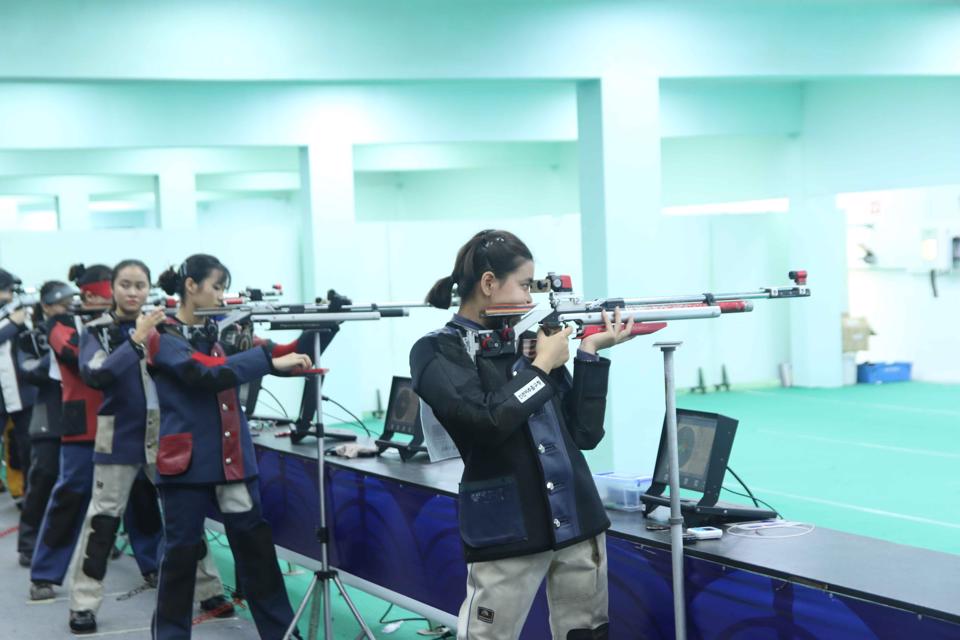Recently, the Ministry of Labor, War Invalids and Social Affairs issued Circular 11/2020/TT-BLDTBXH on the List of arduous, hazardous and dangerous occupations and works, and extremely arduous, hazardous and dangerous occupations and works in Vietnam.
.jpg)
Studying, producing and processing COVID-19 vaccines is considered a hazardous and dangerous occupation in Vietnam (Internet image)
According to Circular 11/2020/TT-BLDTBXH, there are up to 66 occupations in the fields of healthcare and pharmacy that are considered arduous, hazardous and dangerous. One of these occupations is studying, producing and processing vaccines and serums for prevention and treatment of diseases.
Currently, the list of arduous, hazardous, and dangerous occupations and works, and extremely arduous, hazardous, and dangerous occupations and works in the healthcare and pharmacy fields, is specified across several decisions, including Decision 1152/2003/QD-BLDTBXH, Decision 915/LDTBXH-QD, and Decision 1629/LDTBXH-QD. In total, there are only 54 arduous, hazardous, and dangerous occupations and works in the healthcare and pharmacy fields specified in these decisions. It can be seen that Circular 11/2020/TT-BLDTBXH was issued to summarize information and add 11 more hazardous occupations.
Specifically, the 64 physically demanding, hazardous, or dangerous occupations in the healthcare and pharmacy fields are listed as follows:
|
No. |
Occupation or work |
Working conditions |
|
Class-VI working conditions |
||
|
1 |
Directly examining, treating and serving people infected with HIV, AIDS. |
Extremely arduous work; facing high risk of being infected with incurable diseases; stressful work. |
|
2 |
Performing macroscopic anatomy, shrouding, embalming, post-mortem examination and morgue cleaning. |
Working in frequent contact with dead bodies, harmful bacteria and toxic chemicals; stressful work. Working in frequent contact with smelly and infected viscera, and toxic chemicals. |
|
|
Class-V working conditions |
|
|
1 |
Performing microscopic anatomy and forensic toxicology testing. |
Working in frequent contact with smelly and infected viscera, and toxic chemicals. |
|
2 |
Playing the role of operators, assistant operators, repairing and calibrating irradiation machine, X-Ray machine, MRI scanner, CT-Scanner, PET CT scanner, DSA (digital subtraction angiography) machine, C-Arm machine, linear accelerator, cobalt machine, using radium needles and other radioactive substances serving medical treatment and diagnosis. |
Working in contact with ionizing radiation in excess of permissible limits, and sources of infection. |
|
3 |
Repairing and calibrating surgical suction pumps |
Working in frequent contact with highly infectious wastes. |
|
4 |
Directly examining, treating, testing and serving patients with leprosy, mental illness, tuberculosis and other infectious diseases. |
Frequently working at places posing high risk of infection; stressful work. |
|
5 |
Surgeons, assistant surgeons, anesthetists, emergency and intensive care physicians; monitoring postoperative patients; directly examining, treating and serving neonatal patients. |
Arduous and extremely stressful work; working regardless of time of day or night. |
|
6 |
Directly examining, treating, caring and serving patients with cancer, burn, intracerebral hemorrhage, paralysis, spinal cord injury, traumatic brain injury, children with cerebral palsy, providing end-of-life care for geriatric patients, patients with dementia or stage III-IV pressure ulcers, poisoned patients, and critically ill patients in clinical departments. |
Arduous and extremely stressful work; working regardless of time of day or night; frequently and continuously monitoring patients; operating and using many types of medical machines and equipment. |
|
7 |
Testing for particularly dangerous diseases (cholera, bubonic plague, hepatitis, encephalitis, HIV and other rare and dangerous diseases) |
Working in closed rooms, and in contact with toxic chemicals and microorganisms causing particularly dangerous diseases and posing high risk of infection |
|
8 |
Killing rats, pests and pathogenic bacteria |
Working in frequent contact with dangerous epidemic hotspots and highly toxic chemicals |
|
9 |
Directly collecting, transporting, storing, treating and disposing of hazardous biomedical wastes and amputated body parts. Operating wastewater and waste treatment systems, and dredging sewers in hospitals. |
Manual and arduous work; working in frequent contact with biomedical waste and sources of infection. Working in smelly place and under impact of noise and chemicals (such as NaOH, H2SO4, H2S). Unfixed work; working in contact with dirt, humidity, fungi and microorganisms. |
|
10 |
Manually washing and treating patient clothes. |
Arduous and wet work; working in frequently contact with detergents and dirt posing high risk of infection. |
|
11 |
Producing opium glue and derivatives of opium glue. |
Arduous work; working under impact of heat, noise, herbal ingredient dust and other organic dust; stressful during the shift. Working in frequent contact with organic solvents and toxic chemicals. |
|
12 |
Producing ethers. |
Arduous work; working under impact of solvents and toxic chemicals. |
|
13 |
Producing pharmaceutical chemical products using organic solvents. |
Arduous work; working under impact of solvents and toxic chemicals during production. |
|
14 |
Producing antibiotic materials. |
Working under impact of chemicals, solvents and high-concentration raw-material antibiotics which likely cause allergy and adversely affect health. |
|
15 |
Producing artemisinin and its derivatives |
Working under impact of chemicals, solvents and high-concentration raw materials used for making anti-malarial drugs, which likely cause allergy and adversely affect health. |
|
16 |
Concocting poisons in class A and B. Production and trial production of strong poisons such as morphine, synthetic camphor, terpin hydrate, strychnos nux-vomica and datura extracts, and class A poisons. |
Working under impact of chemicals, solvents and high-concentration drugs and toxic chemicals which likely cause allergy and adversely affect health. |
|
17 |
Grinding, sieving, concocting antibiotics, hormones, psychotropic drugs, narcotic drugs, anti-malarial medications. |
Working under impact of chemicals, solvents and high-concentration raw materials which likely cause allergy and adversely affect health. |
|
18 |
Producing gypsum powder (crushing rock, putting rock into oven, setting fire for oven, taking gyps out of the oven, grinding, and packacking) and producing lead molds. |
Arduous and manual work; working under impact of high temperature, silica dust, CO, CO2 in excess of permissible limits |
|
|
Class-IV working conditions |
|
|
1 |
Working at facilities providing treatment of leprosy, tuberculosis and mental illness. |
Frequently working in environment posing high risk of infection. |
|
2 |
Directly examining, treating and serving patients with dermatological or venereal diseases, arteriosclerosis obliterans, external haemorrhoids, genitourinary, artificial anus, and endoscopy. |
Working in frequently contact with ulcers and wound odor; facing high risk of infection. |
|
3 |
Performing deliveries, examination and treatment of gynecological diseases, and childbirth assistance |
Arduous work; solving complicated works with high risk of infection; stressful work. |
|
4 |
Printing X-ray films. |
Working in closed room lacking light; optical strain; working in contact with toxic chemicals. |
|
5 |
Giving massage, acupressure, therapeutic exercises, osteopathy, plaster cast. Using high-frequency machines and microwave in medical treatment. |
Arduous and stressful work |
|
6 |
Orderlies in health facilities. |
Manual and arduous work; working in contact with wastes and pathogenic microorganisms |
|
7 |
Washing, drying, sterilizing and disposing of medical devices, samples, laboratory bottles, bottles/vials containing drugs, vaccines, serum and biological preparations. |
Working at a wet place and in frequent contact with chemicals and dirty wastes posing high risk of infection, NaOH, other toxic substances and sources of infection. |
|
8 |
Inspecting vectors (flea, tick, aphis, mite, malaria vector mosquito, filarial nematode, hemorrhagic fever, encephalitis); performing epidemic investigation, surveillance and control. |
Dangerous work; working in forest, mountainous and border areas, and on islands with high risk of infection. |
|
9 |
Performing quarantine in border areas and seaports. |
Working at sea, in border areas and on islands, and in contact with toxic chemicals and pathogenic microorganisms |
|
10 |
Doing researches on chemicals used for killing disease vector insects |
Working in frequent contact with toxic chemicals which may adversely affect human health. |
|
11 |
Studying, producing and processing vaccines and serums for prevention and treatment of diseases. |
Working in poorly-ventilated closed rooms, and in contact with toxic chemicals and infected cattle; facing high risk of infection. |
|
12 |
Performing microbiological, biochemical and hematology tests Performing food safety and hygiene tests: testing for mycotoxins, natural toxins, pesticide residues, antibiotic residues, hormones, heavy metals, physiochemical parameters, additives and food processing aids, finding causes of food poisoning |
Working in closed rooms and in contact with toxic chemicals and pathogenic microorganisms which pose high risk of infection, air compressors, noise; facing high risk of fire and explosion. Working in frequent contact with microorganism factors, natural toxins, pesticide residues, heavy metals, etc. which may adversely affect human health. Working in contact with toxic chemicals in laboratories such as acetyl nitrate, pyridine, hexane, etc. which may cause cancer or gene mutation. Working with machines, pressure and chemicals used in testing. |
|
13 |
Keeping microorganism and parasite strains/species |
Working in frequent contact with blood samples and infected cattle which may transmit diseases. |
|
14 |
Performing works serving hemodialysis and endoscopy. |
Static working posture; optical strain; working in contact with samples. |
|
15 |
Directly examining, treating and serving patients at outpatient and emergency departments. |
Frequently working in environments with high risk of infection; stressful work. |
|
16 |
Repairing medical machines and equipment at sickrooms and laboratories. |
Hard work; static working posture; working in frequent contact with grease, oil, chemicals and at places with high risk of infection. |
|
17 |
Finding, exploring and harvesting herbs. |
Arduous work; a lot of travel; frequently working in forest and mountainous areas. |
|
18 |
Drying herbal ingredients with zinc phosphate and sulphur. |
Working in frequent contact with high-concentration toxic chemicals. |
|
19 |
Doing research in herbal ingredients and testing for pharmacology, chemotaxonomy, oriental medicine and pharmacokinetics in treatment of diseases. |
Working in frequent contact with organic solvents, toxic chemicals and infected animals. |
|
20 |
Directly dehydrating, crushing, sifting, grinding, kneading and mixing herbal ingredients manually and semi-manually in traditional medicine hospitals. |
Arduous work; working under impact of heat, noise and herbal ingredient dust. |
|
21 |
Producing silica gel absorbers, burettes (mother solutions) for chromatography analysis. |
Working in frequent contact with highly toxic and dangerous concentrated acids (such as H2SO4, HCl, HNO3...) |
|
22 |
Taking samples and analyzing environmental and occupational health hazards for preventive health system and epidemic prevention. |
Working under impact of workplace hazards |
|
23 |
Producing absorbable sutures. |
Working under impact of heat and toxic chemicals |
|
24 |
Processing, blending, rolling, pressing, centrifuging, vulcanizing rubber for producing medical instruments (controlling condom/rubber glove dipping and forming machines, collecting rubber gloves, and vulcanizing rubber products) |
Working in frequent contact with toxic chemicals, high temperature and stench. Working in frequent contact with heat, noise, dust and toxic chemicals. |
|
25 |
Keeping and storing chemicals at packaging facilities |
Physical and manual work; working in contact with heat, noise, chemical vapors, toxic herbal ingredients, and toxic chemicals. |
|
26 |
Breeding laboratory animals serving medical research and vaccine production. |
Working in frequent contact with animal manure and sources of infection. |
|
27 |
Manually decocting. |
Working in confined space, and under impact of heat, CO and CO2. |
|
28 |
Producing pharmaceutical chemical products using strong inorganic acids, strong alkalis, alcohol, and pine essential oil |
Working in frequent contact with organic solvents and toxic chemicals. |
|
29 |
Raising snakes and extracting venom from snakes |
Working in frequent contact with venomous snakes; stressful work; facing life-threatening risks. |
|
30 |
Producing Chloral hydrate and cloramine. |
Working in contact with vapors of disinfectants which adversely affect human health. |
|
31 |
Dissolving, condensing, collecting, rinsing, drying, grinding, sieving, and packing pharmaceutical chemical products. |
Arduous work; stressful during the shift. Working in frequent contact with organic solvents and toxic chemicals. |
|
32 |
Extracting and refining active ingredients from herbal ingredients |
Working in frequent contact with organic solvents and toxic chemicals which may adversely affect human health. |
|
33 |
Stewing herbal glue and animal glue |
Working according shifts, and in contact with heat, herbal vapors, and vapors of solvents used in extracting herbal ingredients and animal glue. |
|
34 |
Chopping, seasoning, drying, removing molds from herbal ingredients manually |
Physical and manual work; working in contact with heat, noise, chemical vapors, and herbal ingredients. |
|
35 |
Grinding, sieving, mixing, and preparing active ingredients and excipients; operating tablet/blister coating and packaging machines |
Physical and manual work; working in contact with heat, noise from packaging/coating machines, vapors of chemicals, herbal ingredients and excipients. |
|
36 |
Producing and packing balm and ointment. |
Working in frequent contact with vapors of organic solvents, chemicals and essential oil which may adversely affect human health. |
|
37 |
Preparing, packing and sealing injectable drugs by vacuum-packing method; packing and sealing powdered antibiotics. |
Physical and manual work; working in contact with heat, noise from stirring/sealing machines, vapors of chemicals, herbal ingredients, excipients and antibiotics. |
|
38 |
Producing drugs from offal, subtilis. |
Facing risk of infection with biological agents from offal; working in contact with chemicals and solvents during production. |
|
39 |
Operating thermal water distillation machines |
Working in frequent contact with high temperature, noise; manual and stressful work. |
|
40 |
Manually soaking, rinsing and cleaning syringes. |
Arduous work; static working posture; working under impact of heat |
|
41 |
Extracting and experimentally producing pharmaceutical chemical products. |
Working in frequent contact with vapors of solvents, chemicals and pharmaceutical chemical products which may adversely affect human health. |
|
42 |
Manually loading materials, herbal ingredients, pharmaceuticals, etc. at health facilities. |
Physical and manual work; working in contact with heat, noise, chemical vapors, and herbal ingredients. |
|
43 |
Directly testing pharmaceutical chemical products, pharmaceutical products and cosmetics; performing physical chemistry, chemotaxonomy, oriental medicine and pharmacology analysis Testing medicines and pharmaceutical starting materials. |
Stressful work; working in frequent contact with vapors of pharmaceutical products and cosmetics |
|
44 |
Keeping warehouses, preserving materials and poisonous pharmaceutical ingredients of class A and B |
Arduous work; working in contact with toxic chemicals, heat and dust. |
|
45 |
Washing, cleaning, drying and ironing hospital bed sheets, blanket, pillow, mattress, etc. |
Arduous and wet work; working in frequently contact with detergents and dirt posing high risk of infection. |
|
46 |
Doing industrial cleaning job in medical equipment and pharmaceutical factories. |
Arduous work; working at hazardous workplace and in frequent contact with toxic chemicals. |
 Article table of contents
Article table of contents





.Medium.png)
.Medium.png)
.Medium.png)
.Medium.png)
